-
Car Reviews
- All reviews
- Midsize SUVs
- Small cars
- Utes
- Small SUVs
- Large SUVs
- Large cars
- Sports SUVs
- Sports cars
- Vans
Latest reviews
- Car News
-
Car Comparisons
Latest comparisons
- Chasing Deals
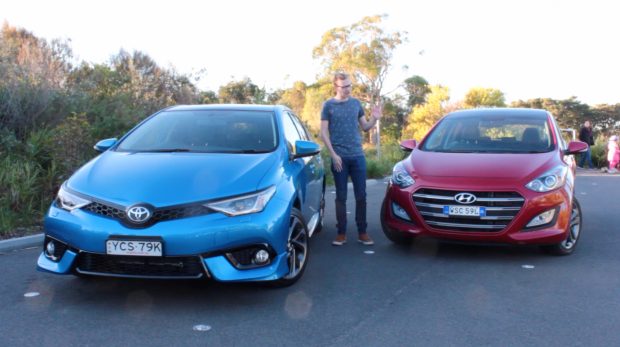
Forty different new small cars are sold in Australia. Forty! That’s an enormous number for a small, crowded and competitive market. Small cars remain the toughest battleground in new car sales. 20,000 find buyers every month, and most manufacturers have a model invested in the fight.
Despite the enormous choice on offer for buyers, recent years have seen the small car war come down to a fight between the Toyota Corolla and the Hyundai i30. They might be similar in size—in fact, they’re just 4cm apart—but the Corolla and i30 drive in very different ways, and their styling and looks are pretty different, too.
The Corolla might have been Australia’s favourite car for a long time, but recent months have seen the i30 romp into the #1 spot more than once. So, which is best?
We borrowed a 2016 Toyota Corolla ZR ($28,990) and a 2016 Hyundai i30 Premium ($34,490) to find out. With one in five of you heading out on the weekends looking for a small car, now more than ever is the time to pitch a Toyota Corolla v Hyundai i30 fight. We’ll look at how they drive, how they look outside and in, and what they’re like to own.
The Toyota Corolla is a zippy, light car to drive around town. Most people will choose the automatic transmission, which is optional on the base model but standard on the range-topping ZR. Toyota recently improved this automatic to make it quieter, and it pairs well with the 103kW petrol engine. In town, the Corolla is quiet and comfortable. There’s not much engine noise or road noise that makes its way into the interior.
It’s still a CVT type automatic that the Toyota uses, though. At higher speeds, on the freeway, things get noisier and more boomy, and the good low-speed ride becomes a bit unsettled. In all, the engine is zippy and the Corolla is nimble, though not particularly refined.
If you plan to mostly drive in town, you’ll like the Corolla’s very light steering. Parking is very easy, thanks to every Corolla coming with a reversing camera. The back window is narrow, but otherwise vision out of the Toyota is fine. If you’re after a car that offers no-fuss city transport, the Toyota Corolla continues to be a very recommendable option.
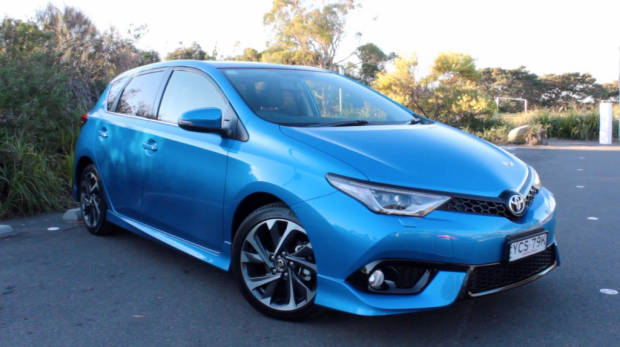
The Hyundai i30 is a more refined car to drive, particularly if you go for the diesel engine that was standard on our Premium model. The 1.6-litre four-cylinder is very strong. There is an enormous amount of pulling power, which makes the Hyundai i30 diesel a superb highway performer. However, in town, the i30 feels heavier than the Corolla, though this isn’t necessarily a negative. In fact, the i30 diesel feels very similar to the best-in-class Volkswagen Golf. Hyundai do give you options, though, and those that prefer a zippy feel akin to the Corolla can choose from 1.8-litre or 2.0-litre petrol engines.
The diesel motor also gives the i30 a seven-speed double-clutch automatic. This is an excellent transmission, keeping out of the way, never letting the car become too loud.
The Hyundai may not feel as light as the Toyota to steer, but it offers excellent handling. In fact, the i30 is fun to drive and feels sporty. The steering gives you much more feedback than the Corolla, and the i30 really sticks to the road. The downside is that to achieve this strong handling, ride quality isn’t quite as comfortable. Potholes and bumps upset the Hyundai more than they do the Toyota.
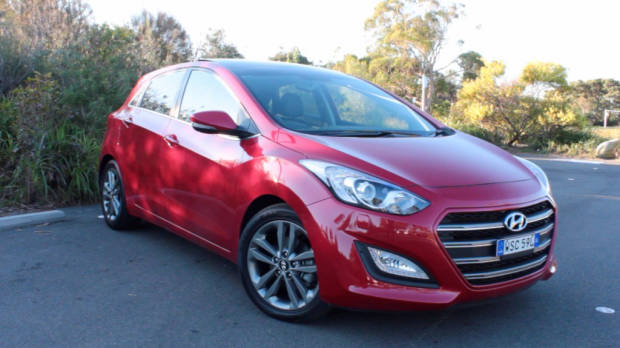
The Toyota Corolla was updated for 2016, and depending on the trim level you choose, the car will have one of two style packages. The lower models, the Ascent and Ascent Sport, are styled conservatively. The sportier SX and ZR trims, though, get an aggressive body kit from the American version of the Corolla—and the electric-blue that our car was delivered in really makes the Corolla stand out on the road.
That said, the hard lines and meaner stance of the Corolla won’t be for everybody. The same can be said for the Toyota’s interior, which is pretty futuristic. The steeply-raked dashboard is a love-it-or-hate-it design touch. What is definitely a positive is the large touchscreen that now comes on every Corolla. This controls the music—and on higher models, navigation as well.
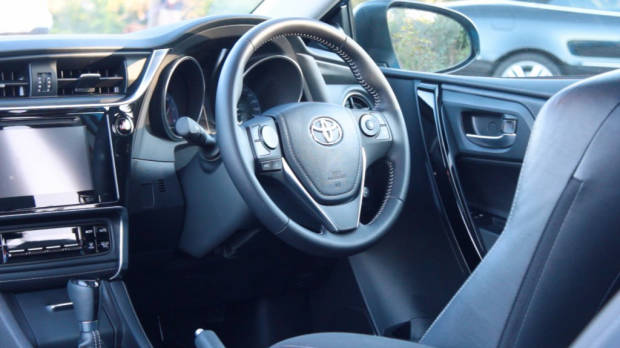
The ZR model comes with leather, and the front seats are particularly good in this model. They have strong bolstering which keeps you in place in the corners. In fact, if you can splash out on the ZR, the comfortable seats alone may be the convincing factor.
Your passengers in the back have a tighter fit. The ZR’s glass roof (that unfortunately doesn’t open) eats into headroom and six-footers will only just fit. Legroom is also a little bit tight in the Corolla. The boot is also inexplicably small, offering just 280 litres of space.
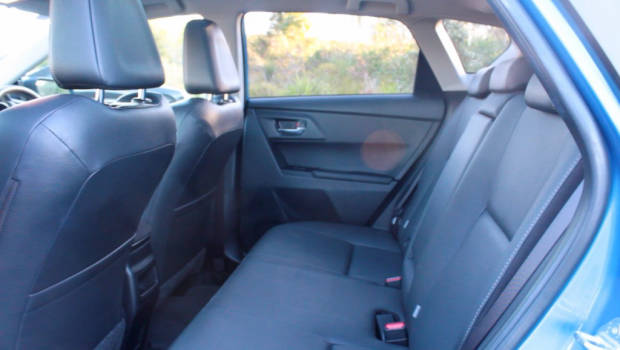
The Hyundai i30 has avoided the radical styling of the Corolla, in favour of a more handsome and toned-down face. Our burgundy i30 Premium was quite the looker, though, and while it is more expensive than the Corolla ZR, the Hyundai looks and feels like the more luxurious car. The proportions and lines of the i30 look classy.
Inside the i30, things are also much more conventional than in the Corolla. We preferred the sweeping, organic dashboard of the Hyundai, which is where the seven-inch touchscreen is housed. The Hyundai navigation system remains the easiest to operate in any car, with big buttons, and a simple method for entering destinations fast.
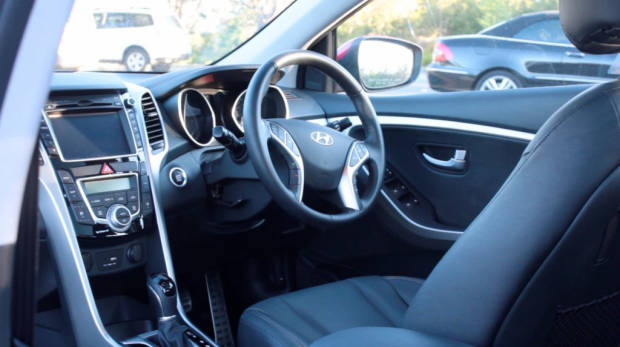
The leather trim of the i30 Premium doesn’t feel as soft as that in the Corolla ZR. The seats are comfortable nonetheless, with the same shape of seat offered across the i30 range. Your back is well supported, and long journeys will be very doable in the comfortable driver and front passenger seats.
There is also more room in the back of the i30—particularly in the headroom department. The seats are still not great for comfort, and only two adults will really fit, but the space is pretty usable. The i30’s opening sunroof lets in plenty of light and doesn’t eat into headroom for your passengers in the back. The 378 litre boot is much bigger, with plenty of room for luggage.
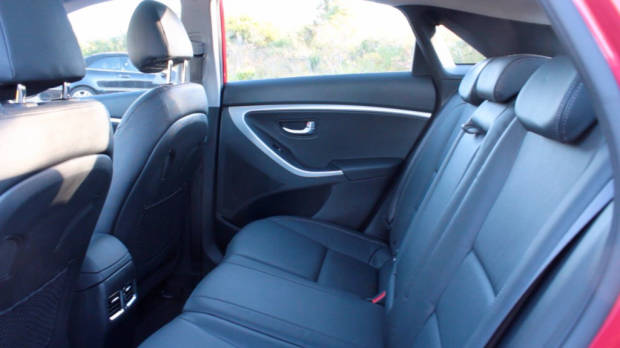
The Toyota Corolla hatchback is available in four different models, from the basic Ascent manual ($19,790, add $1,000 for the automatic) to the ZR automatic ($28,990). Although the ZR has luxurious features like leather seats, dual zone climate control and LED headlights, the model to buy is the SX automatic ($25,490). The SX keeps the ZR’s comfortable seats, looks sporty, and has standard navigation.
The Hyundai i30 is available in five different models, ranging from the basic Active 1.8-litre manual ($20,990, add $2,300 for the automatic) to the Premium diesel automatic ($34,490). The Premium feels luxurious and is more of a rival to higher-spec Volkswagen Golfs. Good value can be found in the Active X diesel ($26,990). That may be $1,500 more than the Corolla SX, but the stronger engine, excellent transmission and more refined nature all mean that extra money doesn’t go to waste.
Every Toyota Corolla uses the same 103kW petrol four-cylinder, so each model has about the same fuel economy: 6.7L/100km in mixed town and highway driving. You can fill the Corolla with E10 petrol, which in 2015 averaged $1.304 per litre. If you drive the average of 14,000 kilometres per year, you’ll spend $1,223 a year to keep the Corolla fuelled up.
The Hyundai i30 comes with engine options, but our recommendation is the strong and efficient 100kW turbodiesel. This engine uses 4.9L/100km in mixed driving. Diesel fuel averaged $1.301 per litre in 2015. Driving 14,000 kilometres a year in the Hyundai will see you spend $892 in fuel. That’s almost 30% less than you would spend in the Toyota.
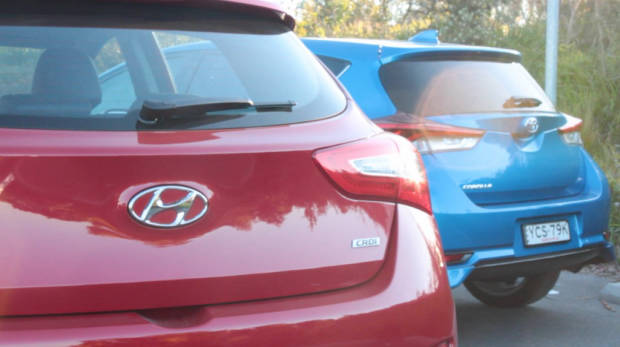
Both the cars benefit from very good value servicing. Both Toyota and Hyundai offer excellent capped-price servicing plans that make it easy to predict how much these cars will cost to maintain.
The Toyota Corolla is covered by the Toyota Service Advantage system. You have to service it every six months or 10,000 kilometres—whichever comes first. That’s six services in the first three years, but each one is capped at $140 each. For three years of ownership, you’ll spend $840 to service the Corolla. After three years, though, the services become uncapped in price and start to get more expensive.
The Hyundai i30 runs under the Hyundai Lifetime Service Plan. This means the servicing is capped in price for the lifetime of the i30, which provides excellent certainty around how much the car will cost to maintain for many years. We look at the first three years in detail. The service intervals are every 12 months or 15,000 kilometres—whichever comes first. Each of these annual services will cost $289 for the first three years, or $867 total. Though prices rise after these three years, they are capped so you know what you will be spending.
The 2016 Toyota Corolla SX costs $25,490 to buy new. After three years of ownership having driven the average of 42,000km, you’ll fetch around $15,300 selling the Corolla SX privately. That works out to the Corolla holding about 60% of its value after three years.
The 2016 Hyundai i30 Active X diesel costs $26,990 to buy new. After driving it for 42,000km over three years, you could expect around $16,200 if you were to sell it privately. So, the i30 holds exactly the same amount of its value: 60%.
Both the 2016 Toyota Corolla and the 2016 Hyundai i30 excel at what they are built to do. These cars are designed to be simple, effective and pleasant city transport. But they go about achieving this mission in very different ways.
The Toyota Corolla is a light and zippy car that is really easy to drive in town. Drive it out on the highway, though, and the shortcomings of its ageing petrol four-cylinder start to become obvious. Though the recent update means it’s now more distinctively styled, the aggressive lines will be an acquired taste for some.
The Hyundai i30 is a product of a surging car company pouring enormous amounts of money into research and development. Because of that, it feels closer to the excellent Volkswagen Golf, especially if you go for the diesel. It drives like a bigger, more expensive car and has attractively low running costs. It may not be as interesting to look at, but the toned-down styling of the Hyundai doesn’t bore and is already ageing better.
A test drive of both is in order, if you’re in the market. But we would write our cheque to the Hyundai dealer offering the best price.
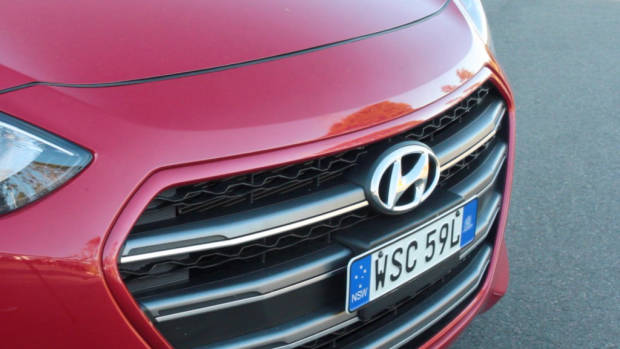
Latest comparisons
About Chasing cars
Chasing Cars reviews are 100% independent.
Because we are powered by Budget Direct Insurance, we don’t receive advertising or sales revenue from car manufacturers.
We’re truly independent – giving you Australia’s best car reviews.